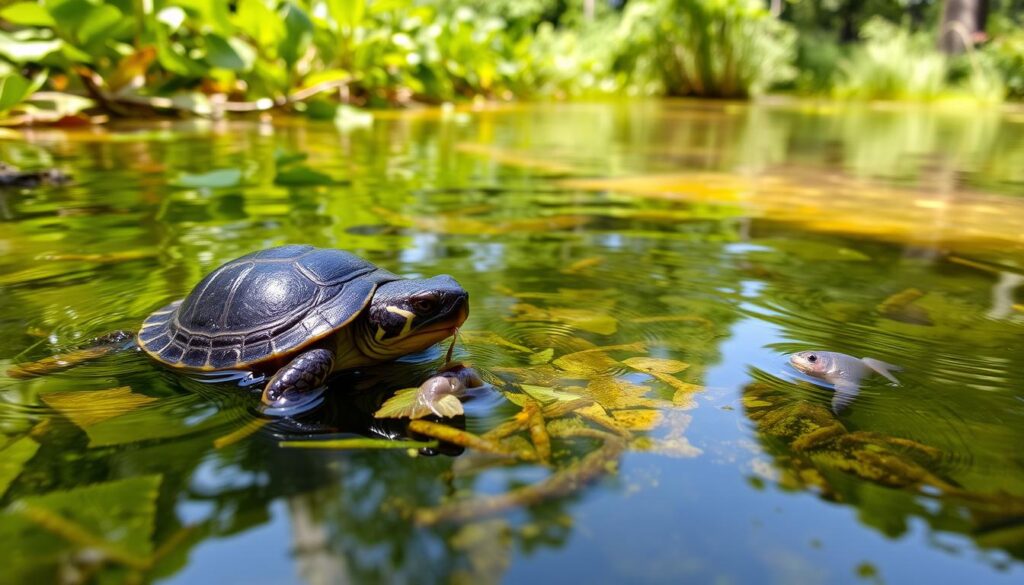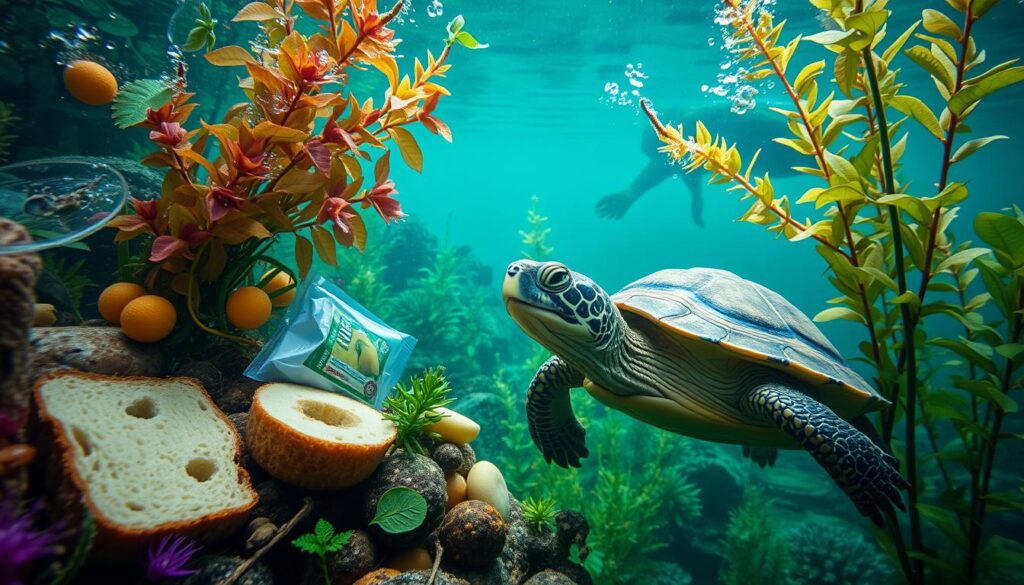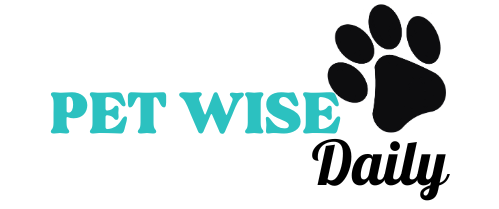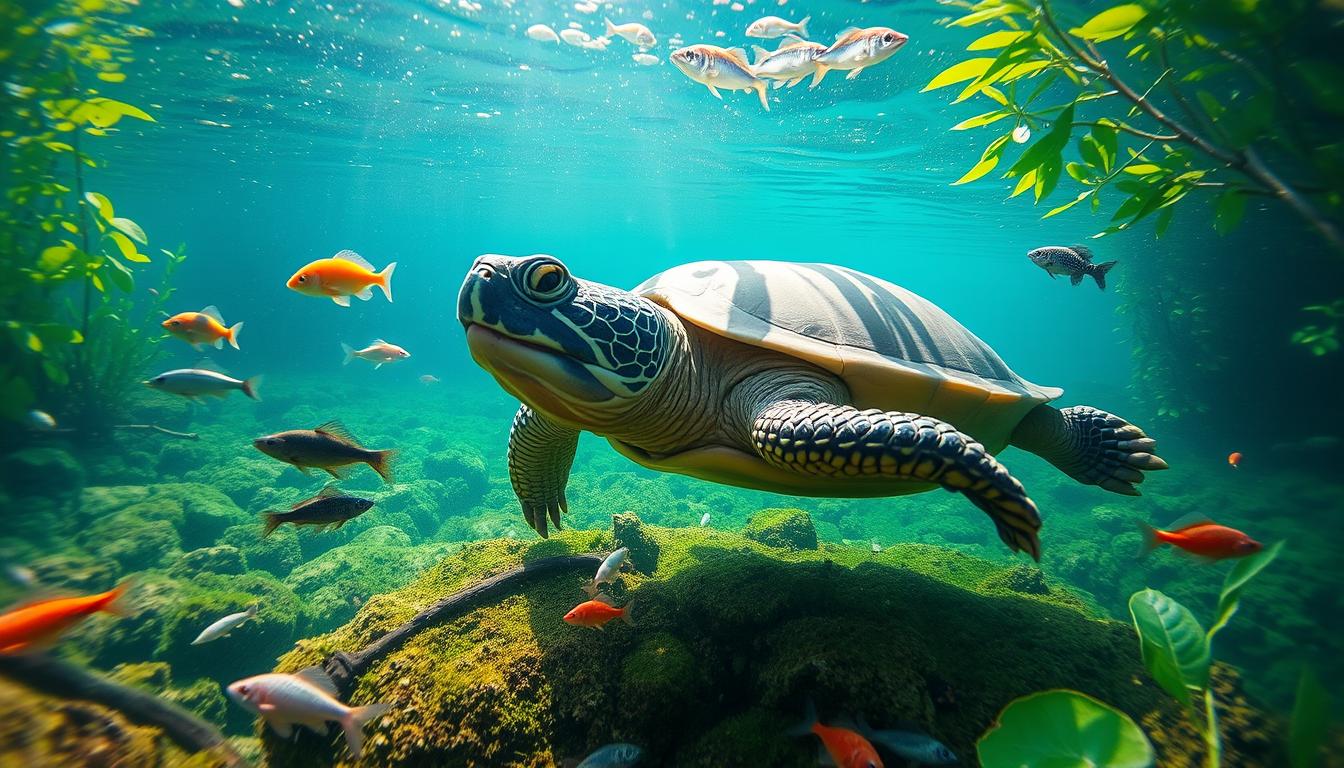Ever curious about what these big reptiles eat? Snapping turtles are known for their strength, but their eating habits might surprise you. They munch on everything from tiny sea creatures to green plants, keeping them healthy in their homes.
Snapping turtles, like the alligator and common types, eat a lot of different things. They enjoy tadpoles, fish, frogs, and even snakes. The alligator snapping turtle is special because it waits in the water, looking like a worm, to catch its food.
But they don’t just eat meat. They also eat plants like algae and water lettuce. Sometimes, they even get treats like strawberries and bananas.
Table of Contents
Understanding Snapping Turtles and Their Natural Habitat
Snapping turtles are fascinating creatures found in North America’s waterways. They have unique ways of eating and adapting to their homes. Let’s dive into the different types, where they live, and how they eat in the wild.
Different Types of Snapping Turtles
There are two main snapping turtle types: the Common Snapping Turtle and the Alligator Snapping Turtle. The Common Snapping Turtle lives in ponds, lakes, and rivers in the eastern and central U.S. and Canada. The Alligator Snapping Turtle, however, is mostly in the southeastern U.S., in swamps and slow rivers with muddy bottoms.
Natural Habitat Requirements
Snapping turtles love water, spending most of their lives in it. They prefer places with slow water, like ponds and streams, for food and places to rest and nest. They also do well in swamps and brackish waters, and even some city waterways, as long as they have what they need to survive.
Feeding Behavior in the Wild
Snapping turtles eat what they can find, using their strong jaws and beaks. They munch on fish, insects, small mammals, and birds. The Alligator Snapping Turtle has a special way of catching prey, using its tongue to lure it close.
Knowing about snapping turtles’ homes and how they eat is key to protecting them. By understanding their role in nature, we can help keep their numbers healthy for the future.
What Do Snapping Turtles Eat: Natural Diet Composition
Snapping turtles eat a wide variety of foods. They are true omnivores, eating both animals and plants. Their diet changes based on what’s available in their environment.
The snapping turtle natural diet includes:
- Fish, such as small bass, catfish, and carp
- Amphibians like frogs, salamanders, and tadpoles
- Crustaceans like crayfish and aquatic insects
- Small mammals, birds, and snakes
- Carrion and decaying organic matter
They also eat plants, like:
- Aquatic vegetation like water lilies, duckweed, and hydrilla
- Terrestrial plants such as leaves, moss, and various berries
- Algae and aquatic ferns
Snapping turtles can live in many places, from ponds to marshes. Their strong jaws and varied diet help them thrive. They are important in keeping their ecosystems balanced.
Animal Protein Sources in a Snapping Turtle’s Diet
Snapping turtles are meat-eaters, mainly eating animal proteins. They eat fish, insects, and small animals. This makes them good hunters in their natural homes.
Fish and Aquatic Prey
Snapping turtles catch and eat many small fish like minnows and bass. They also eat frogs and crustaceans like crayfish and shrimp.
Insects and Invertebrates
They also eat insects and invertebrates like crickets and earthworms. These small creatures are important for their diet.
Small Animals and Birds
Snapping turtles hunt small mammals, birds, and other reptiles. They eat nestlings, ducklings, and even small geese. They have even eaten smaller turtles, showing they are cannibals too.
By eating a variety of animal proteins, snapping turtles get the nutrients they need. This snapping turtle carnivorous diet helps them grow and stay healthy. It lets them be good hunters in their ecosystems.
| Prey Type | Examples |
|---|---|
| Fish and Aquatic Prey | Minnows, bass, frogs, crayfish, shrimp |
| Insects and Invertebrates | Crickets, mealworms, earthworms, spiders |
| Small Animals and Birds | Nestlings, ducklings, geese, smaller turtles |
“Snapping turtles are skilled predators, capable of catching a wide variety of prey to satisfy their snapping turtle carnivorous diet.”
Plant Matter and Vegetation in Their Diet
Snapping turtles are mostly meat-eaters, but they also eat plants. These plants give them fiber and help balance their diet.
Some important plants in a snapping turtle herbivorous diet are:
- Aquatic plants like algae, duckweed, water hyacinth, and water lettuce
- Terrestrial leaves and plants, such as common arrowhead and bog moss
Aquatic plants for snapping turtles are full of vitamins and minerals. They help keep these turtles healthy. Eating both meat and plants, snapping turtles get all they need in the wild.
| Turtle Species | Dominant Diet |
|---|---|
| Green Sea Turtle | Marine grasses and algae |
| Painted Turtle | Omnivorous, including worms, algae, and plants |
| Common Snapping Turtle | Aquatic invertebrates, fish, aquatic vegetation, and carrion |
| Leatherback Turtle | Tunicates, squids, and jellyfish |
| Spotted Turtle | Omnivorous, including aquatic insects, worms, fish, spiders, green algae, and cranberries |
| Common Musk Turtle | Algae, snails, tadpoles, crayfish, clams, and other aquatic insects |
Different turtles eat different things. This shows how important it is to know what each turtle needs to eat.
“Turtles play a crucial role in the animal food chain by predating on organisms that feed on them, helping to keep populations in check, and scavenging on dead organisms to maintain ecosystem balance.”
Feeding Requirements for Pet Snapping Turtles
Caring for a pet snapping turtle means knowing their diet needs. These reptiles have special feeding needs for their health. We’ll look at what they eat, from commercial foods to how much and when.
Commercial Turtle Food Options
Commercial turtle pellets should be 25% of their diet. These pellets have the right mix of nutrients for growth. Choose brands made for snapping turtles.
Dietary Supplements and Vitamins
Snapping turtles also need supplements like calcium and vitamin D3. These help keep their shells strong and support bones and muscles. Talk to a vet or reptile expert to find the right supplements.
Feeding Schedule and Portions
Feeding times vary with age and size. Young ones might eat every day, while adults eat 3-4 times a week. Feed about 3% of their body weight at each meal to avoid overfeeding.
Keeping a good pet snapping turtle diet and snapping turtle feeding requirements is key. A balanced diet, supplements, and a careful feeding plan help your turtle thrive.
Baby Snapping Turtle Feeding Guide
Caring for baby snapping turtles means paying close attention to their diet. They need more protein than adults. A mix of commercial turtle food, live prey, and fresh greens is key for their growth.
For feeding baby snapping turtles, you have several options. Commercial turtle pellets or flakes are a mainstay, offering important nutrients. Add small live prey like minnows or crickets for extra protein.
Leafy greens like kale or romaine lettuce are also good. They provide fiber and vitamins. Make sure to cut these greens into small pieces for easy eating.
Don’t forget to add calcium and vitamin supplements. They help with bone growth and overall health. Sprinkle these over their food or mix them into the water.
- Feed baby snapping turtles daily, adjusting portion sizes as they grow.
- Ensure that prey items are appropriately sized to prevent choking hazards.
- Maintain the water temperature in the tank between 75°F and 80°F, with a warm basking spot at around 90°F.
- Provide a tank size of at least 20 gallons to accommodate the turtle’s growth.
| Food Item | Recommended for Baby Snapping Turtles |
|---|---|
| Commercial Turtle Pellets/Flakes | ✓ |
| Small Live Fish (Minnows, Guppies) | ✓ |
| Aquatic Insects (Crickets, Worms) | ✓ |
| Leafy Greens (Kale, Romaine, Watercress) | ✓ |
| Calcium and Vitamin Supplements | ✓ |
By offering a balanced baby snapping turtle diet and using proper feeding techniques for young snapping turtles, you can help them grow and thrive.

Seasonal Changes in Feeding Patterns
As seasons change, so do snapping turtles’ eating habits. These reptiles adjust their diets to fit the changing environment all year.
Summer vs Winter Feeding Habits
In warmer months, snapping turtles eat more and are more active. They hunt for fish, insects, small animals, and birds. This helps them store energy for the cold seasons.
When winter comes, their eating habits change. Many snapping turtles go into brumation, a reptile hibernation. Their bodies slow down, and they stop eating. They use stored fat to survive the cold.
Brumation Period Considerations
Caring for snapping turtles in brumation needs special care. You must adjust their food to match their slower metabolism. Overfeeding can harm them, so watch their diet closely.
Knowing how snapping turtles eat changes with the seasons helps care for them. This ensures they stay healthy all year.
Foods to Avoid and Potential Hazards
As pet owners, it’s important to know which foods are bad for your snapping turtle. These amazing reptiles need a special diet to stay healthy. Some foods can harm them, so it’s key to avoid them.
Spinach and beet greens are high in oxalic acid. This can mess with your turtle’s mineral absorption, causing health problems. Also, too much fruit can upset their stomachs because of the sugar.
Make sure your turtle doesn’t eat toxic plants like azaleas, hydrangeas, or poinsettias. Eating these can be very dangerous or even deadly. Also, don’t feed them wild animals. These animals might have parasites that can harm your turtle.
Feeder fish are a good protein source, but some have thiaminase. This enzyme can lead to a vitamin B1 deficiency if eaten too much. Always choose the right fish for your turtle’s diet.
| Toxic Foods to Avoid | Potential Dangers |
|---|---|
| Spinach, beet greens | High in oxalic acid, can interfere with mineral absorption |
| Fruits (in moderation) | High sugar content, can cause digestive issues |
| Azaleas, hydrangeas, poinsettias | Toxic plants, can be harmful or fatal if consumed |
| Wild-caught animals | May harbor parasites, pose health risks |
| Certain feeder fish | Can contain thiaminase, leading to vitamin B1 deficiency |
Knowing about these dangers helps keep your snapping turtle healthy. A balanced diet is crucial for their growth and happiness. Always choose the right foods for your turtle’s diet.

Proper Feeding Techniques and Safety Measures
Caring for snapping turtles needs special feeding methods to keep them safe and healthy. It’s important to keep the bones and skin on the food. This helps prevent choking. Use a separate tank for feeding to keep the main habitat clean.
Good hygiene is key when dealing with snapping turtles or their food. Always wash your hands well with soap and water before and after handling them. This helps avoid getting sick. Also, use long tools to feed them to avoid getting bitten by their strong jaws.
- Keep prey items whole with bones and skin intact to prevent choking.
- Shred or slice food into bite-sized pieces for easy consumption.
- Use a separate feeding tank to maintain water quality in the main habitat.
- Wash hands thoroughly with soap and water before and after handling turtles or their food.
- Utilize long-handled tongs or tools to feed snapping turtles and prevent accidental bites.
By following these steps, you can keep your snapping turtle healthy and safe. This also reduces risks for you and your pet.
Common Feeding Problems and Solutions
As a snapping turtle owner, knowing about common feeding issues is key. Problems like overfeeding, nutritional deficiencies, and health issues can harm your pet. It’s vital to address these problems to keep your turtle healthy.
Overfeeding Issues
Feeding too much can cause obesity and shell problems in turtles. It’s important to watch your turtle’s weight and adjust their food. Follow the recommended feeding schedule and limit high-calorie treats.
Nutritional Deficiencies
Snapping turtles need a balanced diet for good health. Deficiencies can cause shell issues, metabolic bone disease, or vitamin problems. Make sure your turtle eats a variety of foods, including proteins, greens, and supplements.
Feeding-Related Health Problems
Eating things they can’t digest can harm turtles. Watch your turtle’s eating and poop closely. If you see any changes or discomfort, talk to a reptile vet. Good feeding habits and a proper habitat are crucial for your turtle’s health.

